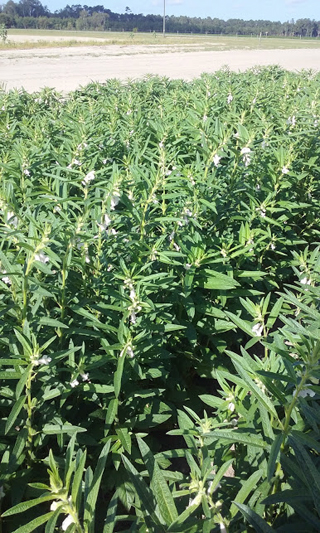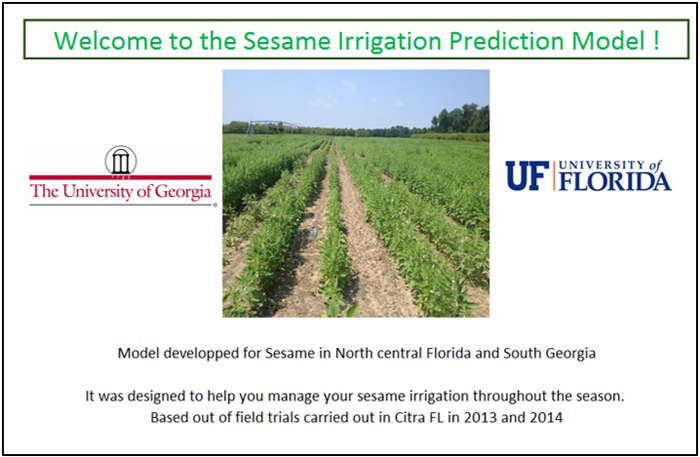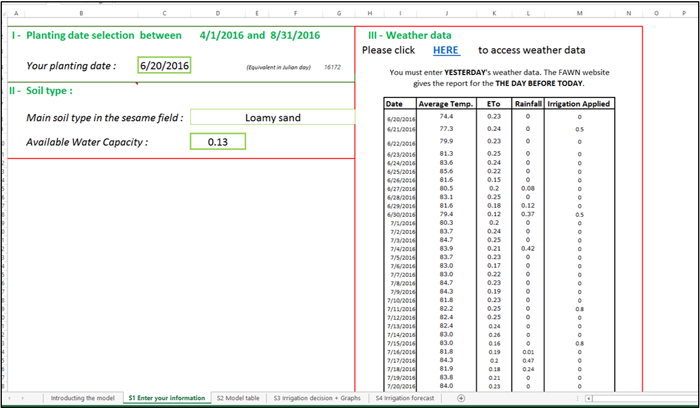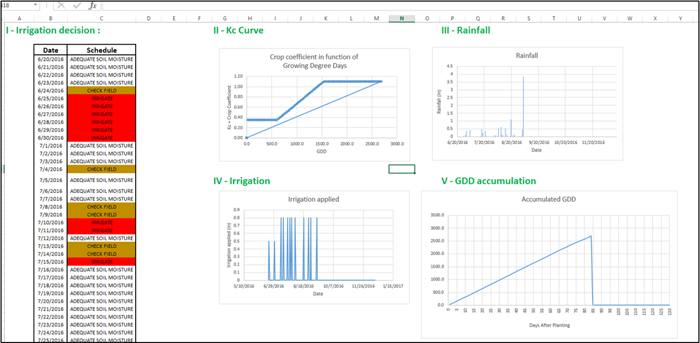 Romain Gloaguen and Diane Rowland, UF/IFAS Agronomy Department
Romain Gloaguen and Diane Rowland, UF/IFAS Agronomy Department
Sesame research has been carried out at the University of Florida (UF/IFAS) for more than 5 years now. Scientist there know more about the crop and its behavior in the Southeastern US than ever before. Research results from multiple aspects of sesame management, such as row spacing, cultivar selection, fertilization rates and timing, planting date and irrigation, is now being compiled and submitted for publication. These results will soon be available to interested growers in the region. The UF/IFAS team has also developed SesameFARM, a new irrigation scheduling model that has a similar platform to the model already available for peanuts called PeanutFARM (http://peanutfarm.org/).
Sesame is known to be a relatively low input crop, able to reach good yields with 60 lbs/ac of nitrogen fertilizer. It is also, and more importantly, drought tolerant. In fact, in some African countries it is the last crop that can be grown when every other crop fails under severe drought. This trait is particularly interesting since water consumption in Florida is likely to intensify in the coming years, accentuating the conflict between urban and farming uses. However, like all crops, sesame will perform better under irrigation.
The purpose of SesameFARM is to help growers with the irrigation management of their crop, taking advantage of its relatively low requirement for water. Sesame is a new crop for most growers in the Southeast, so questions arise about whether to irrigate or not because of the drought tolerant reputation of the crop. Common questions include, “How long can the crop resist a dry period?” and, “How can I determine if the crop is water stressed before the first wilting symptoms appear?” SesameFARM addresses these questions through utilizing phenological measurements of the crop over the past five years of research, and the application of a growing degree day (GDD) model for sesame. The development and validation of the model is a collaborative effort between UF/IFAS and the University of Georgia with Drs. Wes Porter and Scott Tubbs.
 SesameFARM estimates the daily amount of water available for the crop in the soil, compared to the estimated daily amount of water used by the crop. To do so, SesameFARM models root length, canopy development, and water use throughout the season utilizing accumulated GDDs. The user simply inputs the daily average temperature, rainfall, evapotranspiration and irrigation applied, and the model estimates whether irrigation is needed. The weather data can be accessed through the Florida Automated Weather Network (FAWN) (http://fawn.ifas.ufl.edu/) website for Florida, and the UGA Weather Network for Georgia (http://weather.uga.edu/).
SesameFARM estimates the daily amount of water available for the crop in the soil, compared to the estimated daily amount of water used by the crop. To do so, SesameFARM models root length, canopy development, and water use throughout the season utilizing accumulated GDDs. The user simply inputs the daily average temperature, rainfall, evapotranspiration and irrigation applied, and the model estimates whether irrigation is needed. The weather data can be accessed through the Florida Automated Weather Network (FAWN) (http://fawn.ifas.ufl.edu/) website for Florida, and the UGA Weather Network for Georgia (http://weather.uga.edu/). 
The final output from the model is either “Adequate Soil Moisture” when the water supply is sufficient for the crop, “Check Field” when it falls below 70% of the maximum plant available water and “Irrigate” when it falls below 50%. The model can only run with data from the previous day, since the weather stations release their information after a 24 hour cycle. To compensate for this, the model gives an estimate of how many days are left before the next call for irrigation.
An online version of SesameFARM is not yet available, but a free beta version can be obtained upon request to: Romain Gloaguen. If you choose to use it, feedback and suggestions would be greatly appreciated.
- Rapid Response Team Deployed to Investigate Peanut Collapse - September 21, 2018
- Developing a “Stress Breathalyzer” for Peanuts - April 13, 2018
- Peanut Nodule Analysis to Assess Crop Health - August 18, 2017
